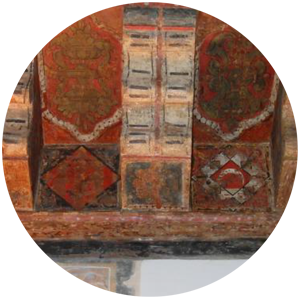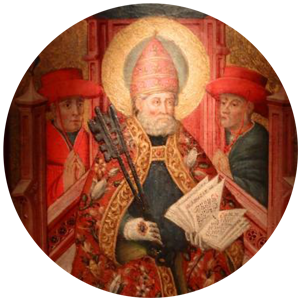We find ourselves in the main hall of the Gothic-Mudejar palace from the 14th century. Most part of this hall has disappeared because of the different alterations of the building made principally in the 16th and 18th centuries.
This roof is the original alfarje (ceiling of a room adorned with carved wood with beams at sight) and shows pictorial decoration from two different moments: the 14th century and the 16th century. We can emphasise some important events developed in this same space, such as the celebration of Sibyl de Fortiá’s coronation in 1381. This queen was King Peter IV’s, the Ceremonious, fourth wife. He was a long-lived king characterized by having a strong determined imperialist feeling which led him to extend Aragonese territory by Mediterranean Sea. Besides, he was a great diplomat and showed interest in culture, founding the University of Huesca in 1354.
This paintings collection joins the best artists of Hispanic-Flemish art in Aragon, underlining authors such as Tomás Giner who was painter for King Ferdinand II of Aragon. There were two main themes in late medieval art as a reflection of the society of that moment: image of Christ as Savoir and saint as models of behaviour.
We find ourselves in the main hall of the Gothic-Mudejar palace from the 14th century. Most part of this hall has disappeared because of the different alterations of the building made principally in the 16th and 18th centuries.
This roof is the original alfarje (ceiling of a room adorned with carved wood with beams at sight) and shows pictorial decoration from two different moments: the 14th century and the 16th century. We can emphasise some important events developed in this same space, such as the celebration of Sibyl de Fortiá’s coronation in 1381. This queen was King Peter IV’s, the Ceremonious, fourth wife. He was a long-lived king characterized by having a strong determined imperialist feeling which led him to extend Aragonese territory by Mediterranean Sea. Besides, he was a great diplomat and showed interest in culture, founding the University of Huesca in 1354.
This paintings collection joins the best artists of Hispanic-Flemish art in Aragon, underlining authors such as Tomás Giner who was painter for King Ferdinand II of Aragon. There were two main themes in late medieval art as a reflection of the society of that moment: image of Christ as Savoir and saint as models of behaviour.

![]()
This coat of arms is reminder of one of the Maecenas who ordered this extension: Pedro IV “the Ceremonious”. This coat of arms represents the Aragon Royal Sign, with a golden flied covered by paly of four gules. The design has its origins in the 11th century when Aragonese King Sancho Ramírez was Pope’s vassal. There are some documents preserved from the Holy See with a cord with these two colours.
The other coat of arms belonged to Archbishop Lope Fernández de Luna, the other promoter in the building extension after a fire in 1372. It is a white crescent half-moon on field gules.

This coat of arms is reminder of one of the Maecenas who ordered this extension: Pedro IV “the Ceremonious”. This coat of arms represents the Aragon Royal Sign, with a golden flied covered by paly of four gules. The design has its origins in the 11th century when Aragonese King Sancho Ramírez was Pope’s vassal. There are some documents preserved from the Holy See with a cord with these two colours.
The other coat of arms belonged to Archbishop Lope Fernández de Luna, the other promoter in the building extension after a fire in 1372. It is a white crescent half-moon on field gules.

![]()
This painting is one of the few portraits of Pope Luna preserved in the Kingdom of Aragon. It was painted in the first half of the15th century following International Gothic style in Aragon. Pope Luna, also known as Benedicto XIII, belonged to Luna family, a famous family with a long ecclesiastic and military tradition.

This painting is one of the few portraits of Pope Luna preserved in the Kingdom of Aragon. It was painted in the first half of the15th century following International Gothic style in Aragon. Pope Luna, also known as Benedicto XIII, belonged to Luna family, a famous family with a long ecclesiastic and military tradition.
